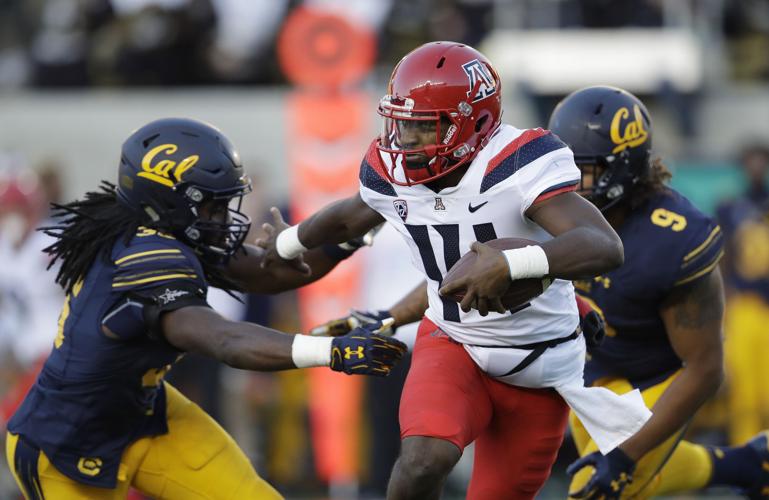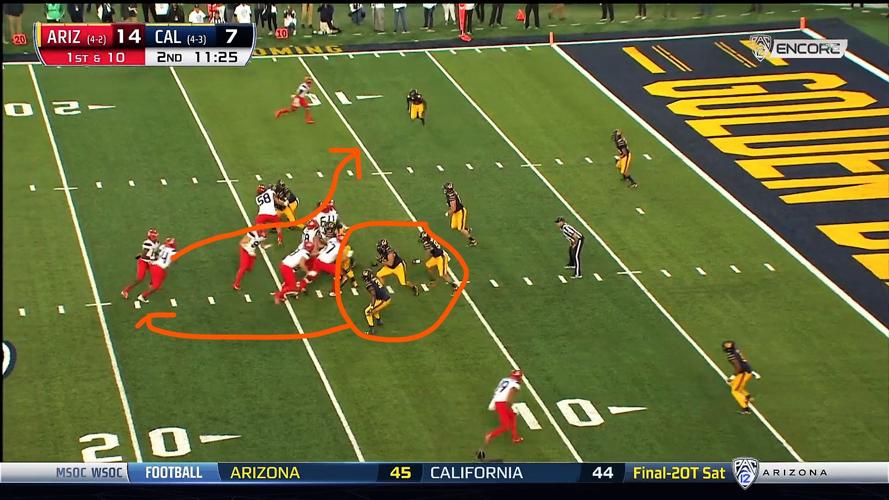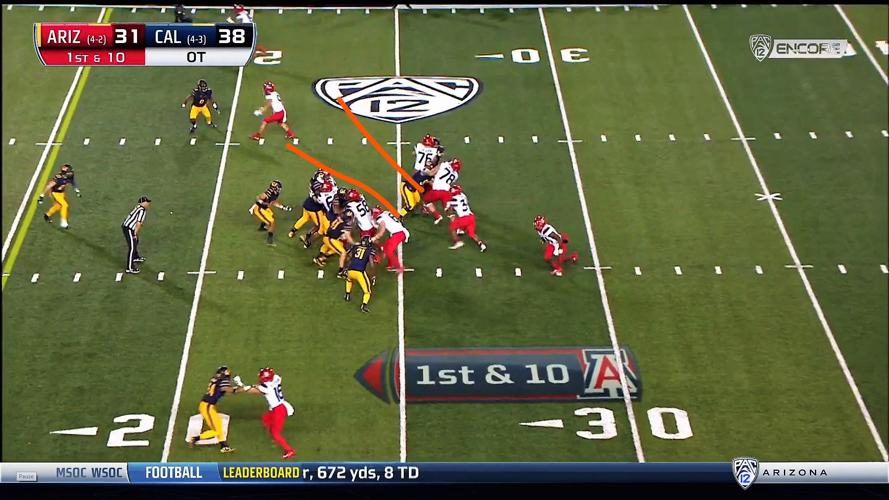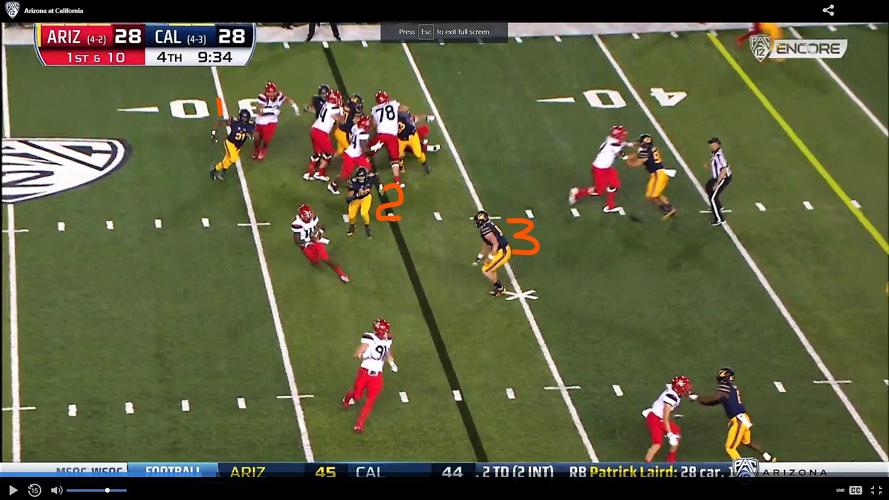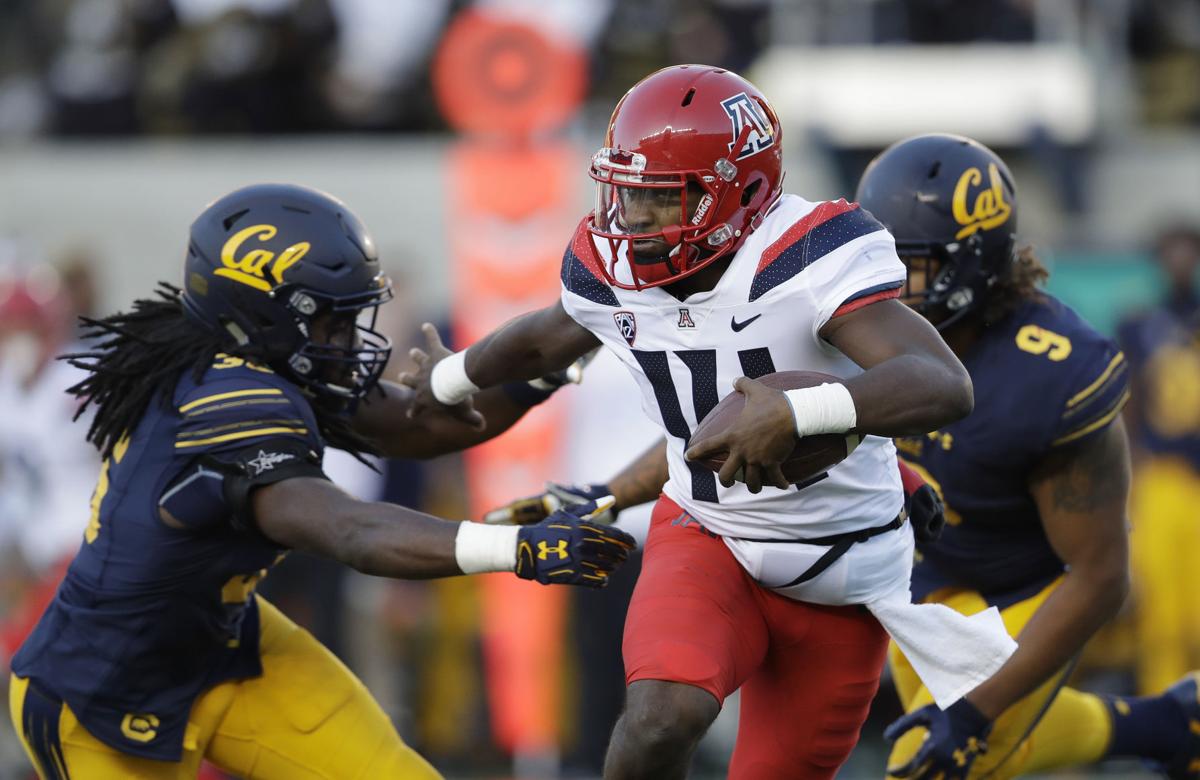Every Monday throughout the season, we’ll take a look back at the Arizona Wildcats’ previous game after re-watching it via the TV broadcast and present five key takeaways. Here are the five from the UA’s 45-44 double-overtime victory over Cal on Saturday night:
1. Run/pass option

Khalil Tate had Shun Brown open on this fourth-quarter play that ended in an INT, but Shawn Poindexter (far right) was open too.
Cal did a better job of containing Khalil Tate than anyone has this season. Tate had just 14 rushing yards in the second half and overtime. The Golden Bears played with good discipline for the most part, and they committed most of their resources to keeping him hemmed in. It was a strategy they were willing to stick with, even if it sometimes yielded huge holes for Arizona’s running backs. How did Tate counter that? With his arm. He had 141 of his 166 passing yards after halftime. I was extremely impressed with Tate’s ability to throw accurately on the run on a fourth-quarter completion to Tony Ellison and on the winning touchdown to Bryce Wolma. Both times Tate had defenders closing in on him, but he maintained his fundamentals and put the ball where it needed to be. Did he need to force the ball downfield at the end of regulation? No. Shun Brown was open underneath. But even that pass wasn’t as bad as it looked; Shawn Poindexter misjudged it by 3-4 yards (kudos to Poindexter for hustling to tackle Ashtyn Davis after the interception). Future foes will try to copy Cal. Tate has the tools to counter those tactics.
2. Going Green

With defenses geared toward stopping Tate, Zach Green found room to run.
Huge props to Zach Green for not only filling in for Nick Wilson (ankle) and J.J. Taylor (ejection) but having the best game of his career. Green ran with tremendous power and determination, consistently falling forward and getting an extra yard or several. The Wildcats wouldn’t have won without him. But the absence of Wilson and Taylor did limit Rich Rodriguez’s play-calling options. While effective between the tackles and maybe quicker than he ever has been, Green isn’t a perimeter threat. Arizona isn’t going to pitch the ball to him or run him to the outside. In essence, the defense has one fewer thing to worry about. Wilson’s status for this week is unknown. I didn’t see how he hurt his ankle, but I did see him walk to the bus without a limp or a boot. Taylor will be back next week. He and Green complement each other well. Might we see Nathan Tilford if Wilson is out vs. Washington State? Maybe. Remember, the coaches went with veteran Kwesi Mashack when Scottie Young Jr. got hurt vs. UCLA. They used the following week of practice to get youngsters Troy Young and Jarrius Wallace ready.
3. Cumulative effect

The Arizona defense started to wear down in the second half. Ross Bowers had a clear path to the end zone on this TD run.
I broke down the numbers on Arizona’s broken third-down defense here. They’re ugly. After re-watching the game, I couldn’t pinpoint any one flaw on those plays. Sometimes the coverage was too soft. Sometimes defenders lost track of receivers when QB Ross Bowers scrambled. Sometimes the Wildcats brought pressure and it didn’t get home. Whatever the case, you can be sure it’ll the primary point of emphasis for the defense this week. What was clear is that all those third-down failures had a cumulative effect on the defense. By the fourth quarter, the linemen were losing their leverage and struggling to hold the point of attack – just like the Colorado game two weeks earlier. The Wildcats rallied in the second overtime and made the Bears fight for every yard near the goal line. But this third-down trend can’t continue – especially if Arizona is down bodies against Washington State. Tony Fields II, Kylan Wilborn and Dereck Boles all left in the second half or overtime because of injuries and did not return. I don’t see the Wildcats beating the Cougars without them.
4. This time it’s personnel

The UA offensive line opened an alley for Green on this 25-yard TD run in overtime.
Every week we provide some notes on individual players, so here goes … Ellison had just three catches for 28 yards, but two of the grabs were in clutch situations and in traffic. Tate trusts him implicitly. … After watching the game a second time, I wish I had given the UA offensive line an A instead of an A-minus. That group is playing at a very high level. (You can still cast your vote here via our interactive report card.) … Every lineman played well. I thought right tackle Gerhard de Beer had his best game of the season. … One thing I’d like to see from Fields, assuming he’s healthy, is more deception when he blitzes. He was telegraphing them early in the game. … Boles showed great hustle on the play in double overtime where he banged helmets with Wallace. … Safety Demetrious Flannigan-Fowles had his best game since the early part of the season. Several times he was willing to take on the Bears’ bruising ball-carriers in the hole. … CB Lorenzo Burns had a tough night; Bowers picked on him repeatedly (as opposed to Jace Whittaker, who was thrown at just a handful of times). But Burns displayed the short memory all corners must have and redeemed himself with a brilliant pass breakup in the end zone in the second OT.
5. What lies ahead

Defenses will continue to do whatever it takes to stop Tate. How will Arizona counter that?
Beating the Cougars will be a tall task even if the Wildcats’ defense is whole. Likewise USC the following week, although the Trojans certainly looked vulnerable in South Bend on Saturday (all season, really). A split is probably the best-case scenario. But if that happens, Arizona would be 6-3 with Oregon State at home up next. Every single UA fan would have taken that in a second if given the choice a month ago. What needs to happen for Arizona to maximize this run it’s on? First of all, as noted, the defense has to fix its third-down problem. On offense, RichRod is well into a fascinating chess match and has the next move. Will he open things up a little more and make defenses pay for overplaying Tate? It comes down to trust. The more Tate plays – the more comfortable he becomes with the deeper recesses of the playbook – the more Rodriguez will be apt to let him drop back and pass. If he can execute those plays, Tate will become that much more dangerous – a scary thought for the rest of the Pac-12.


